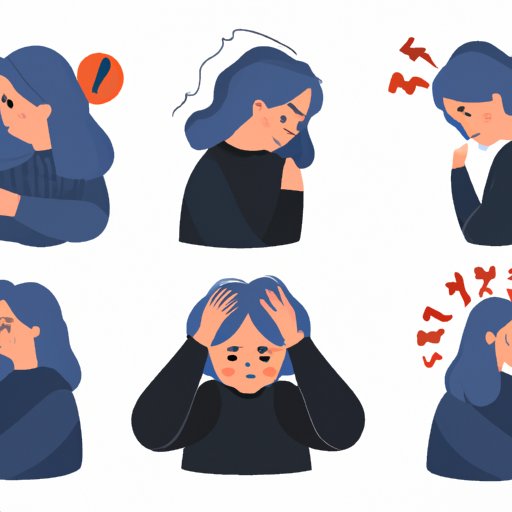
I. Introduction
Panic attacks can be a daunting and scary experience for those who have never experienced them before. They can create a sense of fear and uncertainty that can impact daily living and limit productivity. As we delve into this article, we’ll discuss what a panic attack is, the common symptoms of a panic attack, and ways to cope with the symptoms. Our goal is to create better awareness and understanding of panic attacks, preventing the stereotypes, and misinformation that surrounds it.
II. Understanding Panic Attacks: Symptoms to Look Out For
Panic attacks are an intense feeling of fear that comes on suddenly and usually, without warning. It is a type of anxiety disorder that affects people globally. Panic attacks are short-lived and can last from a few minutes to less than an hour. Some common symptoms of a panic attack include sweating, trembling, breathing difficulties, chest pain, stomach cramps, fear of losing control, and feeling of detachment or unreality.
The impact of panic attacks can be severe as it affects daily life and productivity. It is not uncommon for individuals to develop phobias and avoid activities that trigger their panic attacks. This can lead to social isolation and psychological distress.
III. When Your Body Betrays You: Recognizing the Physical Symptoms of Panic Attacks
The physical symptoms of panic attacks can manifest differently and can vary from one person to another. Some common symptoms include rapid heartbeat, shaking, sweating, shortness of breath, chest pain, nausea, and dizziness. Often these physical symptoms can be a warning sign that a panic attack is about to happen.
It is imperative to differentiate between panic attack symptoms and other health conditions that can mimic panic attacks, such as heart disease, thyroid disease, or hypoglycemia. It’s crucial to be aware of your symptoms and discuss them with a qualified medical practitioner to rule out any underlying medical condition.
IV. Mental Health Matters: Identifying Panic Attack Symptoms in Yourself and Others
In addition to physical symptoms, Panic attacks can create psychological symptoms that leave an individual feeling overwhelmed and vulnerable. Psychological symptoms may include fear, detachment, derealization, depression, and anxiety. These symptoms can end up disrupting daily activities and affect work, school, or other family commitments. It is essential to recognize these symptoms as early as possible to address them promptly.
Identifying panic attack symptoms in yourself or others can be a challenging task, and it is always up to the individual whether they want to share their experiences or not. Stigma surrounding mental health can lead individuals to hide and avoid discussing their symptoms altogether. However, the more we share our experiences, the more we can help others, create awareness and break the stigma.
V. Coping with Panic Attacks: Tools and Techniques for Managing Symptoms
There are numerous ways to cope with panic attacks that can help manage and reduce the severity and frequency of symptoms. Breathing exercises such as deep breathing, meditation, and mindfulness practices can help calm the mind and body and reduce feelings of panic. Cognitive-behavioral therapy (CBT) is also another effective way of managing panic attack symptoms where individuals learn to change their thought patterns that trigger their symptoms.
Self-care plays a crucial role in recovering from panic attacks. Some self-care practices include regular exercise, a healthy diet, and getting sufficient sleep. It is essential to take time out of your day to relax and unwind to reduce feelings of stress and anxiety. Don’t forget that there are also many resources for coping with panic attacks, such as support groups, helplines, and online resources.
VI. No Shame, No Stigma: Breaking the Stigma of Panic Attack Symptoms
There is a negative stereotype and misconception surrounding panic attacks and mental health. It is often labeled as a weakness, which creates a sense of shame and guilt for individuals who experience panic attacks. This stigma prevents individuals from seeking help and support when they need it. It is important to note that panic attacks are not anyone’s fault, and they don’t reflect an individual’s weakness.
Breaking the stigma of panic attack symptoms starts with creating awareness about mental health and challenging the negative stereotypes and misconceptions that surround mental health. Promoting empathy and understanding towards individuals experiencing panic attacks can help dismantle the stereotypes and create a healthier and more supportive community. Seeking help without fear of judgment should be the norm, not the exception.
VII. Conclusion
In conclusion, panic attacks can be a scary and overwhelming experience. But with awareness, understanding, and proper support, individuals can manage and reduce the severity and frequency of symptoms significantly. It is essential to recognize the symptoms and seek help early to address them effectively. Remember, there is no shame in seeking help, and the sooner you seek help, the sooner you can recover. Let us create an understanding and supportive community that promotes mental health and well-being.





